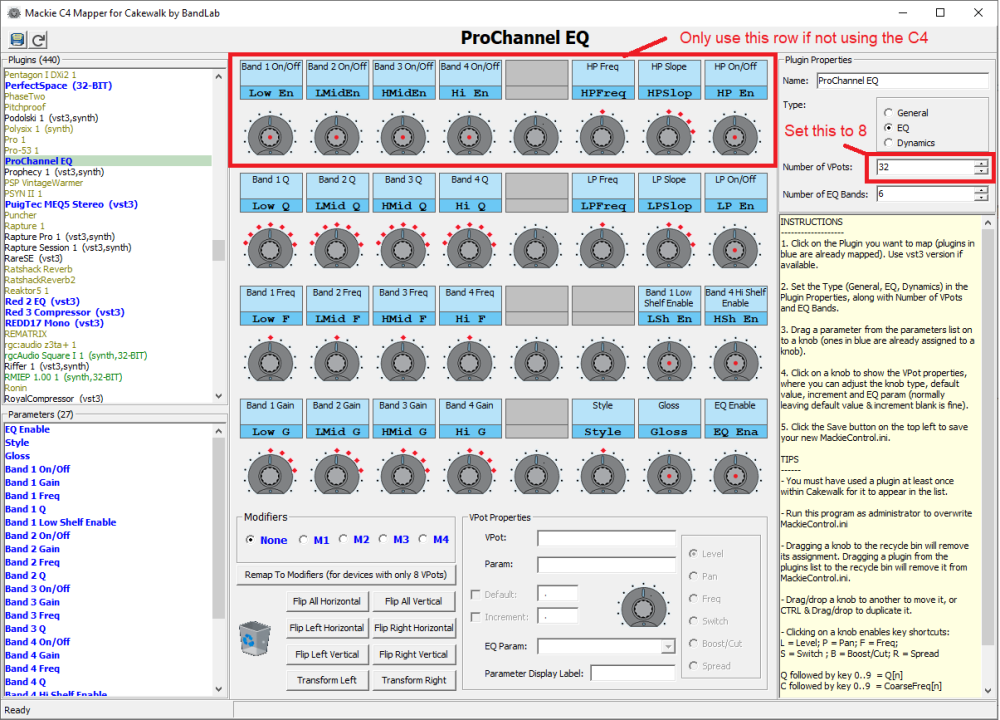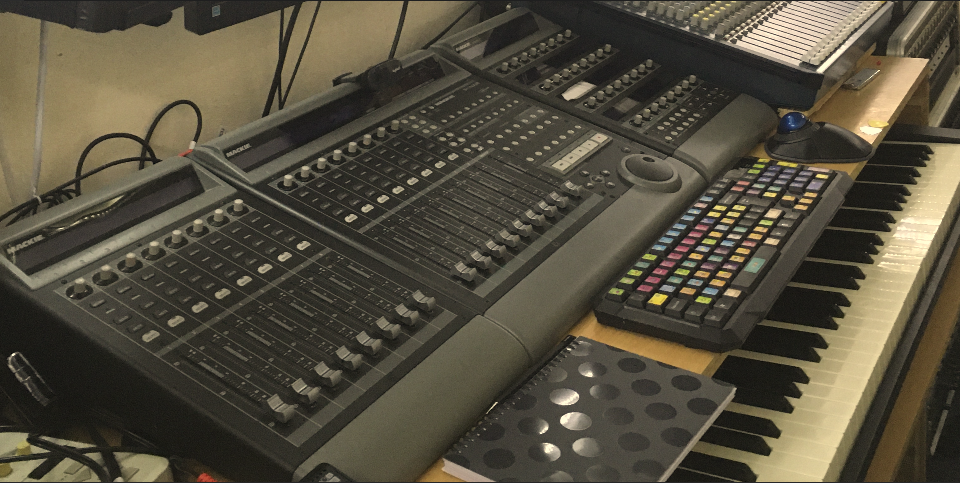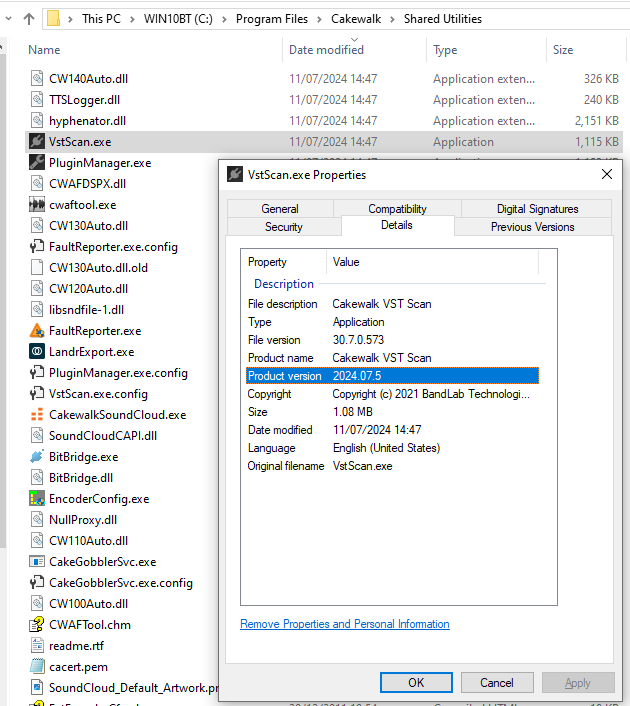-
Posts
6,958 -
Joined
-
Last visited
-
Days Won
36
Everything posted by msmcleod
-
Did you accidently put something into offset mode at one point?
-

MCU Question Regarding EQ/Plugin Functions
msmcleod replied to minminmusic's topic in Cakewalk by BandLab
The differences you're seeing between Mackie Control and MMcL Mackie Control could be down to maybe the MMcL version being an older version, or simply that the configuration in the dialog (under the Utilities menu) is subtly different. As far as the other behaviour, all I can say is every control surface that isn't an official Mackie Control (and especially those without a SONAR mode) has its quirks in MCU mode. In my office, I use an old Yamaha 01X (I removed the mLAN card and built a dongle that hardwires the control surface ports to the ports on the back) and a Mackie C4. The plugin support is actually pretty good on that, but it does have a different set of buttons than the MCU. What it does have though is an official SONAR mode, which means it's sending the correct combination of button presses for various modes. Even so, I find myself getting confused as so many buttons have more that one function (either by pressing them multiple times, or using a modifier button). The name/value display toggling is a common feature of many control surfaces, as is the single track + multiple params vs multiple tracks + single param toggle mode. ANY control surface that isn't an official MCU, unless its extremely basic, is going to be emulating multiple button presses, as they don't have the same buttons as the real MCU. The only possible exception is perhaps the largest Behringer X-Touch model, which seems to have all of the MCU buttons. Also, depending on what functionality they offer, they may have to store internal state (i.e. remembering which mode they think they're in, so that the correct combination of button presses can be sent out). So unless this exactly matches what Cakewalk/Sonar is expecting, there's going to be some weirdness. This is why MCU emulations should really have a SONAR mode. Sure, you can set Cakewalk's Mackie Control emulation to Cubase, but all that does is remap the buttons - it doesn't make Cakewalk/Sonar pretend to be Cubase. The one solution that will almost certainly work is @azslow3's AZController. I used it for a custom hardware controller I was building at one point. It can do pretty much anything, but be prepared for a steep learning curve. To be honest though, I wouldn't get hung up on the slight differences - just pick the solution that works best for you and stick with that. -

MCU Question Regarding EQ/Plugin Functions
msmcleod replied to minminmusic's topic in Cakewalk by BandLab
Pic 1 was just presenting the parameters in order, as it couldn't find MackieControl.ini - take a look at my screenshot of C4 Mapper, and the parameter list on the bottom right. That's the order the parameters are being presented, and that's what you're seeing in Pic 1. -
This is a variation on what I use for my "upload to cloud" script: ROBOCOPY "C:\Cakewalk Projects" "D:\Backup\Cakewalk Projects" *.* /XO /E /COPYALL /DCOPY:DAT ROBOCOPY "C:\Cakewalk Content\Cakewalk Core" "D:\Backup\Cakewalk Content\Cakewalk Core" *.* /XO /E /COPYALL /DCOPY:DAT ROBOCOPY "C:\Cakewalk Content\Audio Library" "D:\Backup\Cakewalk Content\Audio Library" *.* /XO /E /COPYALL /DCOPY:DAT ROBOCOPY "C:\Cakewalk Content\Picture Cache" "D:\Backup\Cakewalk Content\Picture Cache" *.* /XO /E /COPYALL /DCOPY:DAT This is the "download from cloud" script: ROBOCOPY "D:\Backup\Cakewalk Projects" "C:\Cakewalk Projects" *.* /XO /E /COPYALL /DCOPY:DAT ROBOCOPY "D:\Backup\Cakewalk Content\Cakewalk Core" "C:\Cakewalk Content\Cakewalk Core" *.* /XO /E /COPYALL /DCOPY:DAT ROBOCOPY "D:\Backup\Cakewalk Content\Audio Library" "C:\Cakewalk Content\Audio Library" *.* /XO /E /COPYALL /DCOPY:DAT ROBOCOPY "D:\Backup\Cakewalk Content\Picture Cache" "C:\Cakewalk Content\Picture Cache" *.* /XO /E /COPYALL /DCOPY:DAT ... and you set OneDrive (or whatever cloud sync app you use) to sync D:\Backup A quick explanation of the flags: /XO - exclude older files... i.e. skip anything that is newer or the same in the destination /E - include empty folders to ensure the folder hierarchy is preserved /COPYALL and /DCOPY:DAT - copy all the file attributes, e.g. date created, date modified, file owner etc.. you'll need this for /XO to work properly
-

MCU Question Regarding EQ/Plugin Functions
msmcleod replied to minminmusic's topic in Cakewalk by BandLab
It'll be picking up the parameter order from MackieControl.ini, so check that - maybe those parameters aren't listed (I've edited mine, so it'll be different). It should be listed under [ProChannel EQ]. Alternatively, use C4Mapper to check/edit it for you (you'll need to run it as Administrator for it to write back to MackieControl.ini). The reason the first two parameters were different was because it wasn't finding MackieControl.ini in the other directory, so it just presented the parameters in the order it presents them to Cakewalk. -

MCU Question Regarding EQ/Plugin Functions
msmcleod replied to minminmusic's topic in Cakewalk by BandLab
You can't just move these DLL's - they're COM objects. They need to be unregistered first (while they're in the original folder), then re-registered in the new location. The MMcL uninstaller/installer will do this for you - but they need to be in the folders they were originally installed into, for the uninstall to work. -

MCU Question Regarding EQ/Plugin Functions
msmcleod replied to minminmusic's topic in Cakewalk by BandLab
It's probably worth clarifying the "working independently" thing... Cakewalk's Mackie Control, Mackie Control XT and Mackie Control C4 all talk to each other. So I could have five surfaces set up: 2 x XT units, a main MCU unit, and 2 x C4. These would be set up as Mackie Control XT, Mackie Control XT, Mackie Control, Mackie Control C4 and Mackie Control C4. Anything I do on any of the surfaces is "known" by the others, so they're acting as if they're one big control surface. I can add as many additional surfaces to that group that I want by assigning them as one of those three control surface types. MMcL Mackie Control #1, MMcL Mackie Control XT #1 and MMcL Mackie Control C4 #1 work in exactly the same way, except they only talk to other "MMcL ... #1" surfaces. Likewise MMcL Mackie Control #2, MMcL Mackie Control XT #2 and MMcL Mackie Control C4 #2 work in exactly the same way, except they only talk to other "MMcL ... #2" surfaces, and so on. So you essentially have four groups of Mackie Control surfaces that can work independently of each other. -

MCU Question Regarding EQ/Plugin Functions
msmcleod replied to minminmusic's topic in Cakewalk by BandLab
Have you installed the MMcL Mackie Control to the same directory as where your Sonar one is? They should both be in C:\Program Files\Cakewalk\Shared Surfaces\ Your directory should look something like this: All the MackieControl dll's look for MackieControl.ini in the current directory, so if for some reason you have them in different directories and they're looking at a different MackieControl.ini, then that might explain the differences. FWIW - I've just compared the source of the CbB/Sonar version of MackieControl.dll with the source of MackieControl-MMcL - they're essentially the same. The only difference is the registered classId (which has to be different so it comes up as a different control surface), and the fact that the CbB/Sonar version is now code-signed - this is why it's slightly larger in size. The "Exclude Filters" checkbox was added by Azslow3 a few years back - he added support for the Pro Channel EQ and Compressor, which are normally not seen by the Mackie Control (because they're essentially in a different FX bin), so checking that disables that support. So yes, checking "Exclude Filters" then hitting the plugin button will show the first effect in the FX bin. -

MCU Question Regarding EQ/Plugin Functions
msmcleod replied to minminmusic's topic in Cakewalk by BandLab
MMcL vs Cakewalk Mackie Control The MMcL Mackie Control DLL is essentially no different from the stock Sonar one. All the enhancements I did for the MMcL version have been merged back into the Sonar/Cakewalk Mackie Control DLL. When you use the Mackie Control surface DLL (including Mackie Control XT and Mackie Control C4), any control surfaces using them act as a team - so in my setup, the MCU, XT and C4 all act as if they were one big control surface. Changing from tracks to buses for example, will change to buses mode on all three devices. What the MMcL DLL does give you is it allows you to use an additional control surface (or set of control surfaces) independently from another set of control surfaces. In other words, it's not part of the "team" that other control surfaces are in. What you can't see in my picture above is the nanoKONTROL 2 I've got stuck to the wall next to my vocal mic in the corner of the room. This is set to use the MMcL Mackie Control, so that I can control a completely different set of tracks/buses without affecting what the MCU/XT/C4 are using. At one point I had a Behringer BCF2000 that was set to control buses using MMcL Mackie Control, while the MCU/XT/C4 could be set to control tracks. Unless you need that kind of a set up, just stick to the stock Mackie Control DLL. Plugin Parameters As far as parameters are concerned, the parameters available and their ordering is defined within MackieControl.ini. If no entry is found for a particular plugin, you'll get all parameters available in the order they present themselves to Cakewalk. Details on editing MackieControl.ini can be found in the Mackie Control help - or alternatively you could use my C4 Mapper utility which will edit the file for you. You'll want to restrict your parameter/v-pot mappings to the top row only, as the other three rows are only available on the C4. You can download the utility here: https://msmcleod.co.uk/cakewalk/C4Mapper.zip EQ vs Dynamics vs Plugins buttons Within MackieControl.ini, each plugin can be given a type of EQ, Dynamics or General. If you press the EQ button, then you'll only see the EQ plugins; pressing Dynamics will only show you the dynamics plugins. The Plugins button will show all plugins on that track, regardless of type. On the MCU and C4, the up / down cursor keys navigate through plugins, and the left / right keys navigate through the parameters on the current plugin. -
For vocals, you probably want some compression, EQ and either delay or reverb (or both if you want!). Generic settings are unlikely to be of any use as every vocal is different. As far as stock plugins go, you have the choice of using the ProChannel compression / EQ / reverb, or using the Sonitus plugins in the FX rack. You can also use the Sonitus plugins in the ProChannel if you add them into an FX Chain. Here's a couple of guides that will help:
-
I had a bunch of issues with OneDrive - especially with multiple computers, I'd change something on one machine and only to find it'd be overwritten by a change on another. And of course there's the issue you've been having where OneDrive is hijacking files while they're in use. You've got two choices - either: 1. Disable OneDrive completely 2. Configure the directories you want OneDrive to backup so that it's not including your Cakewalk ones: https://support.microsoft.com/en-gb/office/choose-which-onedrive-folders-to-sync-to-your-computer-98b8b011-8b94-419b-aa95-a14ff2415e85 There's a third option, which I use with Mega, but it'll work with OneDrive too... I've got a batch file that copies my projects from my Cakewalk Projects folder to a backup folder, and it's the backup folder that gets sync'd to the cloud.
-
You could use an arranger track to mark each song as a separate arranger section, then export the arranger sections. Each arranger section will be exported as a separate file.
-

MCU Question Regarding EQ/Plugin Functions
msmcleod replied to minminmusic's topic in Cakewalk by BandLab
I'm using Cakewalk with a Mackie Control Universal (MCU), Mackie Control Extender (XT) and Mackie Control C4. I literally have zero problems and it works exactly as it should. I have control to all tracks / buses / mains, all plugins, and all synths in the synth rack. My main workflow is to use the MCU/XT for fader & pan controls, and the C4 for all plugin duties as it has 32 rotary controls. It's far more likely that the iCon isn't behaving like a real MCU than a Cakewalk issue. -

Several New Instrument and Plugin Updates no longer work as VST3s
msmcleod replied to Steve Patrick's topic in Cakewalk Sonar
Once you've copied it to the Shared Utilities folder, you may also need to unblock it - right click, properties then click "Unblock". -
-

Several New Instrument and Plugin Updates no longer work as VST3s
msmcleod replied to Steve Patrick's topic in Cakewalk Sonar
ok - it should say 6.0.7.0 , and the date should be 11th July 2024 (ignore my version number - it's one that was built locally). I've asked the guys to double check the installers. -

Several New Instrument and Plugin Updates no longer work as VST3s
msmcleod replied to Steve Patrick's topic in Cakewalk Sonar
What version is it showing? -

Several New Instrument and Plugin Updates no longer work as VST3s
msmcleod replied to Steve Patrick's topic in Cakewalk Sonar
All I can say is, it's working here. Are you definitely running the latest version of Cakewalk with the newest VST scanner? The error message would indicate it's looking for the VST in the wrong place - which was exactly the issue that the latest VST scanner fixes. FYI - the latest version of Cakewalk is 2024.07 build 108. You can check if you've got the latest version of VstScan.exe, by right clicking on it and choosing properties. The Details tab on the properties dialog will show you the version: -

Several New Instrument and Plugin Updates no longer work as VST3s
msmcleod replied to Steve Patrick's topic in Cakewalk Sonar
It looks like either your MODO BASS 2 install has not worked, or you failed to do a VST Scan after updating. The correct location for the latest MODO BASS 2 should be: C:\Program Files\Common Files\VST3\MODO BASS 2.vst3\Contents\x86_64-win\MODO BASS 2.vst3 Also, make sure you're running the very latest version of CbB / Sonar - earlier versions do not correctly recognise the new VST3 standard of having .vst3 in the directory name. -

In cakewalk , using MSuper looper with multiple output / input
msmcleod replied to Riccoboni's topic in Cakewalk by BandLab
It will be in Cakewalk Sonar only. I'm not sure about Cakewalk Next. -

Help! Some projects take a long time to close.
msmcleod replied to Scott Mallard's topic in Cakewalk Sonar
This is most likely due to plugins freeing up their memory before closing - like you say, the more memory that is being used, the longer this will take. VSTi's such as Kontakt have a "purge" option to remove all samples - you could try using this before closing. You could also try setting sample based synthesisers to load samples on demand and/or limit the amount of memory they can use for samples. Not only will this speed up the closing of projects, it may also speed up project load. The only downside is possible delays in loading the samples on first playback (unless you have very fast RAM / SSD), but it is only on first playback - subsequent plays should be fine. -

In cakewalk , using MSuper looper with multiple output / input
msmcleod replied to Riccoboni's topic in Cakewalk by BandLab
Ah... of course, yes - apologies. Unfortunately, Cakewalk doesn't support multi-output effects - only synths. I'm not sure if it's actually in our to do list yet, but it's been discussed as a future feature in Sonar. -
The RockGuy pack is awesome - models of the Rockman compressor/distortion and chorus/delay mini racks.








